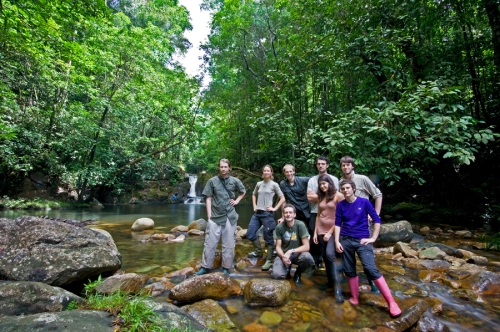4-12; 5-12; 6-12-2012
After we backpacked back towards the road to Lethum(and we did this in a record speed!) we where picked up by a jeep. During the way back to the field station (a small car ride) we saw a Puma walking. We were really lucky, because Philipe told us that this was the second Puma he saw in the 15 years he worked here. Finally back at the field station to spend our last night there. Before that we packaged our specimens in a substance called cheese cloth. You use this to fold around specimens before putting them in plastic closable zip bags. We had one last late night herping trip where we did not find many species or specimens and the next day we took had a car ride back to Georgetown. During our car trip to Georgetown we again saw a cool mammal: a sloth!
The sloth was sitting on the road. It moved, all in line with the species, very slowly. Philipe and Joana grabbed it and moved it towards a tree. The nails/fingers of this three fingered sloth grabbed their fingers fiercely and didn’t want to let go anymore. After we put the animal in the tree, it ran up with all its speed and “disappeared” behind the leaves.
On the last day in Georgetown we had a bit of a vacation day of where we visit a museum, the Iwokrama office (shortly) and some local stores in the city (the markets). Some of us spend their last Gianese dollars at the beautiful Pegasus resort nearby where we had a fabulous meal and drinks. Four hours of sleep where waiting for us that night before we had to check in for the plane that would bring us back to New York and eventually home.
My trip in Guyana and the jungle was a complete new experience for me. It was fairly dry so I didn’t really witnessed the tropical RAINforest, but I did get an impression how collecting specimens is in the field. Collecting specimens for museums as reference specimens of a species is like Philipe said “hard time consuming work which often is forgotten by people working with museum specimens”. People really struggle to get specimens, it can be very hard work under harsh environments. These two weeks have shown this a little bit. We have seen the tip of the iceberg of the biodiversity of reptiles and amphibians in Guyana in these two weeks. In total we’ve seen, and sometimes also captured, 45 species of herps. The trip was tiring but I learned a lot! This was thé trip where the mastercourse of herpetology of the VUB is about. The course where we are actually really searching for and working with the animals we all so love. We all had a lot of fun and for that I’d like to thank my fellow students of this course and off course Philipe as our mentor in the field. Thanks for the unforgettable journey in Guyana!

